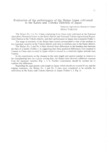Evaluation of The Performance of The Hejiao Lines Cultivated in The Kanto and Tohoku Districts of Japan
Tropical agriculture research series : proceedings of a symposium on tropical agriculture researches
| ISSN | 03889386 |
|---|---|
| NII recode ID (NCID) | AA00870529 |

Full text
tars21-_73-73.pdf112.34 KB
The Hejiao No. 1 to No. 9 lines originating from China were cultivated at the National Agriculture Research Center in the Kanto district and National Tohoku Agricultural Experiment station in the Tohoku district, and their performance in Japan was evaluated (Table 1).
The stage of maturity of the Hejiao lines tested corresponded to that of the medium to late Japanese varieties in the Tohoku district and early to medium ones in the Kanto district.
The Hejiao No. 3 and No. 6 lines showed clear differences in the heading date between the lines of a family (Tables 2, 3), suggesting that these genetical differences were masked in Yunnan in China and revealed in Japan which is located at a relatively higher latitude than Yunnan.
In the experiments on the changes in the culm length and panicle number in relation to the transplanting date for a given sowing date, the Hejiao lines showed a different response from the Japanese varieties (Fig. 1, 2, 3). Further experiments should be carried out to confirm this difference.
Regarding the appropriate culm length in Japan, which should not exceed 85 cm, and the lodging resistance, the Hejiao No. 2 and No. 6 lines were considered to be suitable for cultivation in the Kanto and Tohoku districts of Japan (Tables 2, 3. Fig. 1).
The stage of maturity of the Hejiao lines tested corresponded to that of the medium to late Japanese varieties in the Tohoku district and early to medium ones in the Kanto district.
The Hejiao No. 3 and No. 6 lines showed clear differences in the heading date between the lines of a family (Tables 2, 3), suggesting that these genetical differences were masked in Yunnan in China and revealed in Japan which is located at a relatively higher latitude than Yunnan.
In the experiments on the changes in the culm length and panicle number in relation to the transplanting date for a given sowing date, the Hejiao lines showed a different response from the Japanese varieties (Fig. 1, 2, 3). Further experiments should be carried out to confirm this difference.
Regarding the appropriate culm length in Japan, which should not exceed 85 cm, and the lodging resistance, the Hejiao No. 2 and No. 6 lines were considered to be suitable for cultivation in the Kanto and Tohoku districts of Japan (Tables 2, 3. Fig. 1).
| Date of issued | |
|---|---|
| Creator | Akira Nakane |
| Publisher | Japan International Research Center for Agricultural Sciences |
| Volume | 21 |
| spage | 73 |
| epage | 73 |
| Language | eng |
